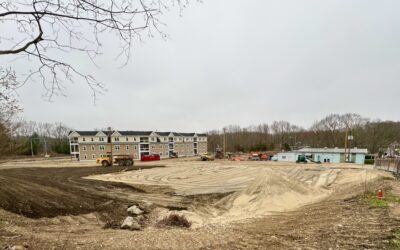May 24, 2017 – A crowd of about 45 people showed up for the Monday, May 22, Town Council meeting, many there to learn more about proposed changes to the affordable housing ordinance. The changes would bring the ordinance into compliance with the town’s Comprehensive Plan, a 197-page document approved in 2013 that acts as a blueprint for the town, addressing everything from disaster planning and economic development to housing and – the issue at hand – affordable housing.
In 2004, the General Assembly approved the Low and Moderate Income Housing Act, which required that by 2025 at least 10 percent of a town’s housing units be “affordable” – that is, 80 percent to 120 percent of an area’s average mean income*.
Today, only 4.6 percent of the town’s housing is considered affordable by the state, putting East Greenwich at risk, said Town Planner Lisa Bourbonnais and Planning Board Chair Mike Donegan Monday night. These proposed changes, Bourbonnais said, would help the town achieve the 10 percent goal and give the town more control over how that goal is reached.
“East Greenwich has not had a development forced on us,” Bourbonnais said. “Barrington has, Narragansett has. East Greenwich has been lucky, given our current ordinance.”
One such development did almost come to East Greenwich in the mid-2000s – 400 units proposed for the site now occupied by New England Tech. Of the 400 units, the developer was proposing 150 be affordable. Because East Greenwich had less than half the requisite number of affordable units, if the town had denied the application, it would have been on shaky ground if the application was appealed. The proposal was withdrawn before the town had to vote on it.
“We have a state mandate that we have to have an affordable housing plan,” said Donegan. “We have to show and negotiate how we are going to get there.”
In other words, not only does the town need more affordable housing units but it needs to prove to the state that it is acting in good faith to reach that goal. And it’s a tough goal, said Donegan, given the high cost of land in East Greenwich compared to neighboring communities.
The ordinance changes can’t fix that, but they could help, he said. In particular, one change would allow developers to locate the required affordable units off-site. For instance, if someone wanted to build 10 single-family houses, 2 would need to be deed-restricted affordable. The market value houses could easily sell for $600,000, but the affordable houses would need to sell for half that. Instead, the ordinance change would allow the developer to build eight $600,000 houses but allow the developer to buy two single family homes or a two-unit apartment building, and sell those two units as affordable, deed-restricted units.
Another change in the ordinance requires that a developer build or provide affordable units at the same rate as the market priced units.
“When someone is going to do affordable and regular, we have no ability to require that the affordable units are built at the same rate as the others,” said Donegan after the meeting.
That happened on Granite Drive when it was extended in 2010. The developer needed to include one affordable house in the project. All the market-value houses were built but the developer never got around to building the affordable unit. It was cheaper – and allowable under the current ordinance – to leave the lot empty. If approved, the new ordinance would not allow that.
During public comment, resident Bill Wray said he opposed the concept of affordable housing because the lower prices for the affordable units end up driving up the cost of the market-value homes, making the situation worse.
He also expressed frustration at what he perceived as the town’s aggressive strategy.
“I think the ordinance goes too far in pursuit of a flawed goal,” he said, referring to the ordinance’s goal of 20 percent affordable units for future developments. “I accept the fact that we have a 10 percent mandate,” said Wray. But, he continued, “I think we’re overreacting to the threat from the state.”
Bourbonnais said the town needed to seek a higher goal for future developments because with the current affordable housing deficit of 5.6 percent, adding only 10 percent to future developments would never close the gap. If and when the town reaches its 10 percent affordable housing goal, then the Council could revisit the issue, Bourbonnais said.
Susan Aitcheson, head of the town’s Affordable Housing Task Force, lauded the proposed changes and noted that the last time the town surveyed residents, the majority were in favor of providing more affordable housing.
Resident Carla Swanson also spoke in favor of the ordinance changes and affordable housing in general. Swanson said she lived in one of the condominiums at the Cottages on Greene Street and that, after two years, she still hadn’t figured out which 3 condos in the 15-unit project were the “affordable” ones.
Council President Sue Cienki said the goal of 10 percent affordable by 2025 was ambitious, but that the town needed to try.
“We may never reach it,” she said, “but I think if the state sees us making progress they’re going to leave us alone.”
This was the second reading of the proposed ordinance. The Council will vote after the third reading, slated for a meeting in the June.
* What is affordable housing, anyway? Rhode Island’s official definition of “affordable housing” means residential housing that has a sales price or rental amount that is within the means of a household that is moderate income or less. In the case of dwelling units for sale, housing that is affordable means housing in which principal, interest, taxes, which may be adjusted by state and local programs for property tax relief, and insurance constitute no more than thirty percent (30%) of the gross household income for a household with less than one hundred and twenty percent (120%) of area median income, adjusted for family size. In the case of dwelling units for rent, housing that is affordable means housing for which the rent, heat, and utilities other than telephone constitute no more than thirty percent (30%) of the gross annual household income for a household with eighty percent (80%) or less of area median income, adjusted for family size. Here’s a link: http://www.housingworksri.org/affordable-homes
Here’s a link to EG’s Comprehensive Plan: https://dl.dropboxusercontent.com/…/2013Adop2014AffdCompPla…
-end-





 Subscribe
Subscribe